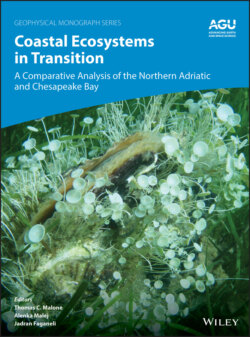Читать книгу Coastal Ecosystems in Transition - Группа авторов - Страница 32
2.4. CONTROLS OF NUTRIENT EXPORT 2.4.1. Nutrient Sources
ОглавлениеWatershed export of nutrients is complex due to heterogeneities in their sources, fates, and transports. In terms of sources, agriculture nonpoint sources, atmospheric deposition, urban (storm water) sources, as well as point sources (wastewater treatment plants) account for most inputs to CB and the NAS watersheds (Ator et al., 2011; Palmeri et al., 2005; Salvetti et al., 2006; Viaroli et al., 2018; Volf et al., 2013). Globally, there is a significant linear correlation between net anthropogenic N supplies to coastal watersheds and total riverine nitrogen export to the coastal ocean (Boyer & Howarth, 2008). However, it should be noted that the major sources and their relative contributions can vary significantly both spatially (as a function of watershed characteristics such as land use, climate, and geology) and temporally (as a function of watershed management, urbanization) (Ator et al., 2011; Carpenter et al., 1998).
Figure 2.2 Boxplots showing seasonal loads of (a) total nitrogen (TN), (b) nitrate + nitrite (NOx), (c) total phosphorus (TP), (d) dissolved inorganic phosphorus (DIP), and (e) suspended sediment (SS) to Chesapeake Bay (four boxes on the left) and the northern Adriatic Sea (four boxes on the right) from tributaries with available data (9 and 13 tributaries, respectively) in 2004–2012.
Figure 2.3 Time series of annual loads of (a) total nitrogen (TN), (b) nitrate + nitrite (NOx), (c) total phosphorus (TP), (d) dissolved inorganic phosphorus (DIP), and (e) suspended sediment (SS) to Chesapeake Bay and the northern Adriatic Sea from their largest tributaries (i.e., Susquehanna and Po, respectively) in 1985–2015. Mann‐Kendall (MK) trend slope and significance (p) values are shown in legend.
For the CB watershed, riverine export of TN was dominated by agriculture nonpoint sources (fertilizer and manure 54%), followed by contributions from atmospheric deposition (17%), point sources (16%), and urban sources (12%). Riverine export of TP was dominated by agriculture nonpoint sources (43%), followed by point sources (32%) and urban sources (11%) (Ator et al., 2011). Typically, nutrients accumulate in watersheds during dry periods of low flows and are transported to receiving waters via groundwater discharge and surface water runoff during wet periods and storm events (Shields et al., 2008; Tesi et al., 2013). Groundwater can represent a major fraction of riverine load (especially N). Bachman et al. (1998) estimated that base flow (a proxy of groundwater input) accounted for 17–80% (median 48%) of the TN load at 36 CB monitoring sites. In addition, riverine export can be strongly modulated by reservoirs. For example, Conowingo Reservoir and two others in the lower Susquehanna River historically trapped about 2%, 45%, and 70% of annual N, P, and SS load, respectively (Langland & Hainly, 1997).
Riverine inputs of TN to the NAS were also dominated by agriculture nonpoint sources (40%) followed by point and urban sources (27%), and groundwater (29%). The TP load mainly originated from point sources and urban sources (43%) and agriculture nonpoint sources (36%) (Volf et al., 2013). For the Po watershed, TN load comes from point sources (40%), nonpoint sources (20%), and groundwater and springs (40%), whereas TP loads come from point sources (80%) and nonpoint sources (20%) (Salvetti et al., 2006).
